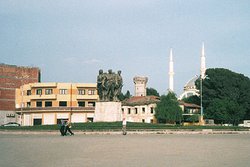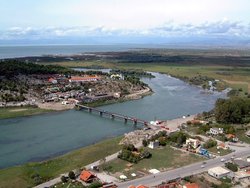|
|
ShkodŽr (Albanian: ShkodŽr or Shkodra, Latin Scutari, German Skutari, Serbian Skadar) is a city located in North West Albania, in the District of ShkodŽr and it is the capital of the County of ShkodŽr. It is located at 42.07°N, 19.51°E on the east side of ShkodŽr Lake, on the southern part of the Mbishkodra plain, between the rivers Drini and Buna.
Muze1.gif
Muze3.gif
Sh-paint.jpg
Statutet.jpg
KishatekKalaj.jpg
The city is one of the oldest in Albania and it is also an important cultural and economic center. It is estimated to have today about 85, 500 inhabitants.
Shkodra was founded around the 4th century BC. This was the site of the Illyrian tribe Labeat as well as the capital of the kingdom of King Gent and that of Queen Teuta. In the year 168 BC, the city was taken by the Romans and it became an important trade and military route for them. In 1040 AD, Shkodra was captured by the Serbs and became an important economic and administrative center of the medieval Serbian state known as Zeta. In 1396, the city came under Venetian rule, forming a coalition against Ottoman Empire.
Shkodra resisted two major Ottoman attacks, in 1474 and 1478-1479, when the city was entirely surrounded by Ottoman forces. It fell under Turkish rule after a heroic struggle in 1479. After the Turkish occupation the city was devastated, and a large number of the population fled. Around the 17th century, the city began to prosper and it became the center of the 'sanjak', Turkish administrative units smaller than 'vilayets'. It became the economic center of northern Albania, its craftsmen produced fabric, silk, arms, and silver artifacts. Two story stone houses were built, the bazaar, and the Bridge of Mesi (Ura e Mesit) over the Kir river, built during the second half of the 18th century, over 100 meters long, with 13 arcs of stone, the largest one being 22 meters wide and 12 meters tall.
In the 18th century Shkodra became the center of the pashallek of Shkodra, under the rule of the Bushati family, which ruled from the year 1757 to 1831. After the fall of the pashallek, the people of Shkodra had a number of uprisings against the Ottomans, in the years 1833-1836, 1854, 1861-1862, and 1869. Shkodra became an important trade center in the second half of the 19th century. Aside from being the center of the vilayet of Shkodra, it was an important trading center for the entire Bakan peninsula. It had over 3500 shops, and clothing, leather, tobacco, and gun powder were some of the major products of Shkodra. A special administration was established to handle trade, a trade court, and a directorate of postage services with other countries. Other countries had opened consulates in Shkodra ever since 1718. Obot and Ulqin served as ports for Shkodra, and later on ShŽngjin. The Jesuit seminar and the Franciscan committee were opened in the 19th century.
Shkodra played an important role during the League of Prizren, the Albanian liberation movement. The people of Shkodra participated in battles to protect Albanian land. The branch of the League of Prizren for Shkodra, which had its own armed unit, fought for the protection of Plava and Gucia, Hoti and Gruda, and the war for the protection of Ulqin.
In the 19th century, Shkodra was also known as a cultural center. The Bushati Library, built during the 1840s, served as a center for the League of Prizren's branch for Shkodra. Many books were collected in libraries of Catholic missionaries working in Shkodra. Literary, cultural, and sports associations were formed, such as "Bashkimi" and "Agimi." The first Albanian newspapers and publications printed in Albania came out of the printing press of Shkodra. The Marubi family of photographers began working in Shkodra, which left behind over 150,000 negatives from the period of the Albanian liberation movement, the rise of the Albanian flag in Vlora, and life in Albanian towns during the end of the 19th and the begining of the 20th century.
During the Balkan Wars and World War I, Shkodra was sought by Montenegro and Serbia. The people of Shkodra had resisted for seven months the surrounding of the town by Serbian and Montenegrin armies. The occupiers finally entered the town in April, 1913, and severely damaged the town and set the bazaar on fire. The Serbian and Montenegrin armies were compelled to leave in May, 1913, in accordance with the London Conference of Ambassadors, which allotted Shkodra to the new country of Albania.
During World War I, Montenegrin forces once again entered Shkodra on June 27th, 1915. In January of 1916, Shkodra was captured by Austria-Hungary and was the center of the zone of their occupation. After World War I, the international military administration of Albania was temporarily located in Shkodra, and in March, 1920, Shkodra was put under the administration of the national government of Tirana. In the second half of 1920, Shkodra resisted another threat, the military intervention of the forces of the Yugoslav kingdom.
Shkodra was center of democratic movements of the years 1921-1924. The democratic opposition won the majority of votes for the Constitutional Assembly, and on May 31st, 1924, the democratic forces took over the town and from Shkodra headed to Tirana. From 1924 to 1939, Shkodra had a slow industrial development, small factories that produced food, textile, and cement were opened. From 43 of such in 1924, the number rose to 70 in 1938. In 1924, Shkodra had 20,000 inhabitants, the number grew to 29,000 in 1938.
Shkodra was the seat of the Catholic archiepiscopacy and had a number of religious schools. The first laic school was opened here in 1913, and the State Gymnasium was opened in 1922. It was the center of many cultural associations, such as "Vllaznia".
Kisha1.jpg
During World War II, the city was invaded by the German armies, and it was not liberated until November 19, 1944.
During the early 1990s, Shkodra was once again a major center, this time of the democratic movement that finally brought to an end the communist rule of the brutal regime established by Enver Hoxha.
Today the city and the area around it is blessed with numerous and different natural and cultural objects. The most attractive quarters with such peculiarities are Serresh and Gijadol, but the most important objects is the castle of Rozafa. The history of the castle starts since the Illyrian times. A very interesting legend explains its history. The main theme of the legend has to do with keeping of promise. Rozafa the bride of the youngest of three brothers, was walled up in order that the walls of the castle do not fall down by the night. The water passing through the stones at the main entrance are connected in the folk fantasy with the water going out from the bossom of Rozafa, which she left out during the time she was walled up in order to feed her little baby.
Statuja.gif
The castle is located in the western part of the city, between Drini and Buna Rivers.
000_0058.jpeg
DerKalase.jpg
Another interesting historical site are the ruins of medieval town of Sarda, situated only 15 km far away from Shkodra. To go there you must take a motor-boat which sails from the dam of Vau i Dejes artificial lake to the island where Sarda is located (10 miles). This boat operates for tourists during the summer times, twice per week. Sarda was a mediaval town with a surface of 5 ha built on the top of the hill surrounded by the waters of Drini river (now artificial lake). It was the residential place of the famous Dukagjini Feudal Family. There was a great prince palace of this family.
Shkodra is an important educational and industrial center. The city produces various mechanical and eletrical components, as well textile and food products. Shkodra is also the site of the Pedagogical Institute and of the Luigj Gurakuqi University of Shkodra. The main library of the city contains more than 250,000 books. Other cultural institutions are the Cultural Center, the Artists and Writers Association, the "Migjeni" (named after Millosh Gjergj Nikolla) Theater, the Gallery of Arts, and the Museum of History. Other noteworthy cultural elements include the Castle of Shkodra (aka Castle of Rozafa), the Turkish Bath, the Mosque of Plumbi.
The very characteristic appearance of the city is formed by the old houses and the narrow streets formed by tall stone walls. After World War II, Shkodra rebuilt with wider streets and new residential buildings. These were built in several new quarters.
See also
External links
- Photo Albums from shkoder.net (http://www.shkoder.net): [1] (http://www.shkoder.net/al/foto1.htm) [2] (http://www.shkoder.net/album/index.htm) [3] (http://www.shkoder.net/foto/foto_mf.htm) [4] (http://www.shkoder.net/foto/foto_j.htm) [5] (http://www.shqiperia.com/foto/galeria/shkodra)
- ALBoZONE: Cities of Albania (http://mysite.verizon.net/vze7b2yg/id19.html)bg:Шкодра
cs:Skadar de:Shkodra et:ShkodŽr fr:ShkodŽr nl:ShkodŽr pl:Szkodra sq:Shkodra sv:ShkodŽr


